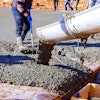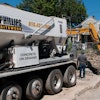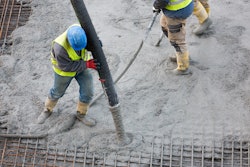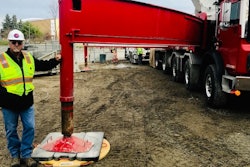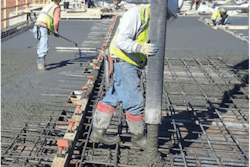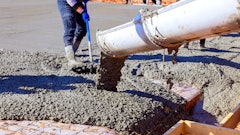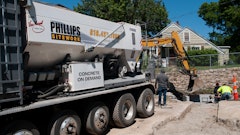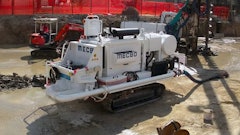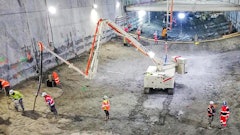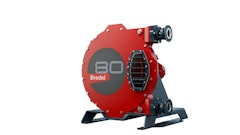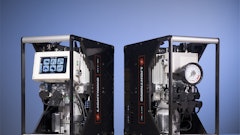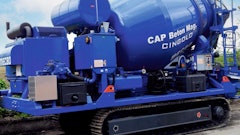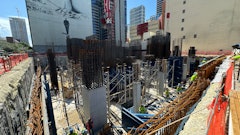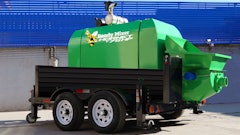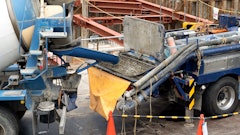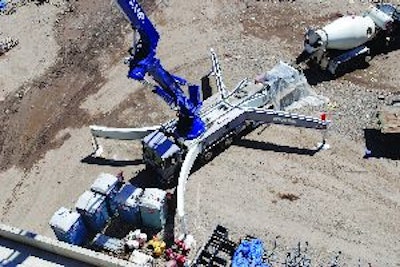
Contractors who use concrete pumps on the jobsite can lower the incidence of a host of manual labor-related safety issues. For instance, concrete pumps have helped eliminate a countless number of back injuries by reducing the need for wheeling, raking and pulling concrete. Pumps also remove the need for stringing together chutes, helping to do away with sprained wrist and shoulder injuries. But to keep your people productive, certain safety practices should be observed when using a concrete pump. Industry and association professionals have shared with us the top safety issues for concrete boom pumps and trailer pumps to help you keep safe while pumping.
Boom pump safety
Power lines are a major concern when using a concrete boom pump, says Christi Collins, executive director for the American Concrete Pumping Association (ACPA), and Chris Hotz of SS&L, Inc. in Omaha, Neb.
Collins says a boom coming in contact with power lines is the number one cause of fatal accidents when using a concrete pump. The ACPA says placing booms should never be operated within 17 feet of working power lines; this is known as the danger zone.
Whether a contractor owns or rents the pump, he needs to be aware of any power lines near the jobsite and inform the pump operator and workers on site of the presence and location of these lines. Everyone on the jobsite should be trained on power line and electricity safety, where the danger zone is, and the purpose of the danger zone.
Collins says when power lines are present a spotter should monitor the movement of the boom and warn the operator away from the danger zone. ?You should never boom over power lines even if it could remain 17 feet away,? Collins adds.
ACPA publishes safety bulletins for boom pump safety, and one of those bulletins focuses specifically on the issue of hose whipping.
?Hose whipping is caused by air that is trapped in the delivery line,? Collins says. When this air is released the end of the hose can whip and cause injury to workers in the area.
It is important to note that air in the delivery system itself is not a hazard. When that air becomes compressed it stores energy, and that is where the risk of hose whipping comes into play.
It is hard to predict exactly when and if hose whipping will occur. ?All personnel should remain a prudent and reasonable distance from the discharge hose when restarting after moving, priming, when air has been introduced into the delivery line, or when a blockage is encountered,? Collins says.
Hose whipping is a danger to anyone within the end-hose movement area, which the bulletin defines as ?the area within the radius of the last flexible (non-steel) piece of delivery system.?
The best way to prevent unnecessary hose whipping accidents is to make sure all the workers are communicating well. In addition, only single-ended hoses should be used on the discharge.
Another safety issue that needs to be monitored when working with boom pumps is tip overs, which are typically caused by outriggers not having enough cribbing or surface area to properly support the unit or allow the outriggers to fully extend, Collins says.
She adds that a contractor needs to be aware of more than just the size of the area. ?The contractor should remove all debris from the set up area and make sure the area is level,? Collins says. Hidden voids or excavations should be clearly marked. It is also essential to make sure the ground conditions can handle the maximum force exerted by the outriggers, Collins adds.
In 2005, the ACPA published a safety bulletin on outriggers. The bulletin suggests that before pumping, the operator should slowly extend the boom over each outrigger. This allows a contractor to see if the outrigger is sinking into the ground, which could cause the unit to tip.
Trailer pump safety
When it comes to using a trailer pump, there are similar and unique safety concerns compared to using a boom pump. Hose whipping is common to both types of pumps. Trailer pumps, like boom pumps, carry a lot of force and the hose can surge and whip if there is a blockage.
?Whoever is manning the hose tip needs to be very careful. You want to have a controlled access zone around the pumping area in case the hose gets away from the operator so that they don?t get sprayed with concrete and the hose doesn?t whip and hit somebody,? says Ron Meschko, director of safety and risk management at Allen Concrete Pumping, Naples, Fla.
Hose whipping is also a concern when cleaning out the pump at the end of a job, Meschko adds. When employees attend Allen Concrete Pumping?s safety training one topic covered is blowout safety. ?This is a situation where air pressure is built up and compressed behind the concrete as the concrete is being pushed through the hose. When the concrete is finally released at the end of the hose, the result is often a violent whip and concrete shooting at an uncontrolled high velocity,? he says.
A trailer pump adds another area of safety concerns, namely the trailer. Meschko says his employees are trained to perform a proper trailer walk-around inspection. ?Trailer pumps need to be maintained and in good working order before they are hauled anywhere,? he says. This includes checking that the trailer is securely attached, hitches are in working condition, all lights and breaks are working, and the tires are properly inflated and have an appropriate amount of tread.
Greg Kerns, field operations manager for Bell and Cook Masonry Inc., Fort Myers, Fla., says employees recheck their trailer pumps every day to make sure everything is in working order. And to make that job easier, the crew is required to clean the pump every day. ?We?re pretty particular about our pumps, and we make sure to pressure wash everything,? Kerns says.
Kerns makes sure that Bell and Cook employees know that pump safety doesn?t stop when the pump is turned off. ?It?s very important when they clean out the machine that they make sure they don?t stick their hands in any moving parts and they use the proper tools to clean the pumps,? he says.
Having the proper licensing to drive and haul a trailer pump poses both a safety and a legal issue for companies. If a driver isn?t properly licensed then the company is employing an illegal driver. The safety side of the issue relates to what a driver needs to know.
?They need to understand what the weights are, truck to trailer ratios, what your stopping distances are and what your traffic requirements are when you?re driving,? Meschko says.
Be prepared
Allen Concrete Pumping requires its employees to attend training sessions and makes use of ACPA videos and safety seminars. All its employees must know proper pump maintenance and the important specs of the different pumps they use. Pump hose operators and pump operators also receive special training for their particular jobs.
Bell and Cook employees read and review all the ACPA safety information. When a new pump is purchased, Kerns says all the pump operators attend the Schwing safety training so they can familiarize themselves with the pump and its safety issues. In addition, Bell and Cook employs a safety coordinator who monitors all pumping projects. Employees also attend a safety meeting every week where pump as well as general safety are reviewed.
?You want to do everything you can to minimize the possibility of a problem or an injury,? Meschko says.
Each safety issue has its own factors and requirements that contractors and workers need to be aware of. But when it comes to the general issue of concrete pump safety, there are a few preventative measures contractors can take even before entering the jobsite.
?A contractor should pre-plan the pour and discuss potential hazards,? Collins says. But the first steps of safety should happen even before a contractor schedules a job.
?They should request safety information and instruct their employees on the hazards of working with a concrete pump,? Collins adds.
The ACPA is one source contractors can turn to for concrete pump safety information. Aside from the downloadable safety bulletins, offered on the ACPA website www.concretepumpers.com, ACPA also offer manuals, videos and co-worker safety seminars. Also, check with your pump manufacturer for any safety recommendations or safety training for employees.



